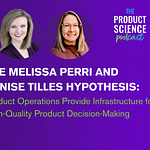Andrew Breen, CEO of Prints of Love and Partner at Buy Build Fund, a seasoned entrepreneur and educator, believes in the power of observing user interactions to uncover the subconscious value people place on products, thereby driving strategic decisions beyond mere spreadsheet analysis. His experience reflects advocacy for addressing often-overlooked value risk and emphasizes the necessity of understanding both emotional and social values in product management. By challenging assumptions and focusing on customer needs, he highlights the importance of understanding both functional and emotional aspects of products, demonstrating how emotional benefits can strongly appeal to consumers and influence behavior.
Resources
Visit Buy Build Fund where Andy partners with investors and business owners
Explore Prints of Love, where he serves as Board Member & CEO
Connect with Andrew Breen on LinkedIn
Visit the Product Science Group website
Explore Product Science Workshops and Courses
Quotes from Andy Breen:
(00:05:57) "It's not about the technology. Just because you build it, they will not come. And you really do need to be solving problems for people and offering them something that changes them and their life and their abilities." - Andy Breen
(00:08:57) "...these days especially every product gets about 30 seconds of consideration, you know, at the top. And so you have to have a clear value proposition." - Andy Breen
(00:26:19) "There are a lot of stay-at-home moms or like people like engineers doing little SAS side projects and stuff that were turning into real businesses, real revenue, real profits, you know, something that's not often talked about in the venture world." - Andy Breen
Lab Notes
Lab Note 606.1: Too many product managers underestimate the importance of assessing value risk.
(00:32:49) “I always come back to value risk. That's, you know, that's the one that people forget, ignore, or just under undervalue.” - Dina Levitan
Lab Note 606.2: Conducting value research often means holding uncomfortable tensions.
(00:33:44) “...We'll have an initial hypothesis and try and get one really early on using the expertise and the knowledge that we have in house [...] while sort of in parallel developing this emerging hypothesis through the discovery work [...] I experienced this qualitatively as a feeling of, like, holding this tension of the unknown that is kind of extending throughout the whole project.” - Mark Enache
Lab Note 606.3: When qualitative and quantitative are telling you the same thing, you’re on your way to product market fit.
(00:35:54) “...the actual product market fit requires that you then design, build, and bring to market the product. This is just the first step. It's almost got a pull of its own that you're like, wow, now everything seems really clear, and it almost seems like it was obvious the whole time, but it wasn't.” - Holly Hester-Reilly
Lab Note 606.4: Continuous Product Discovery has been useful since the 90’s, even if it looks different today.
(00:36:37) “That really spoke to me with the continuous discovery and delivery product science principle. And, you know, it says something about the practitioners in the field, you know, it comes down to that. How fast can you learn?” - Dina Levitan
Lab Note 606.5: Deciding which customer use cases to replace with AI requires evidence-based product strategy.
(00:37:11) “His story around call centers and trying to understand what parts of the activities that go through the call center should and should not be moved to automation and digital experiences was a really a really masterful evidence-based product strategy of coming back and saying, hey, the evidence is showing us that we shouldn't even be trying to remove the human side of the lost card situation. That is a piece of product strategy.” - Holly Hester-Reilly










